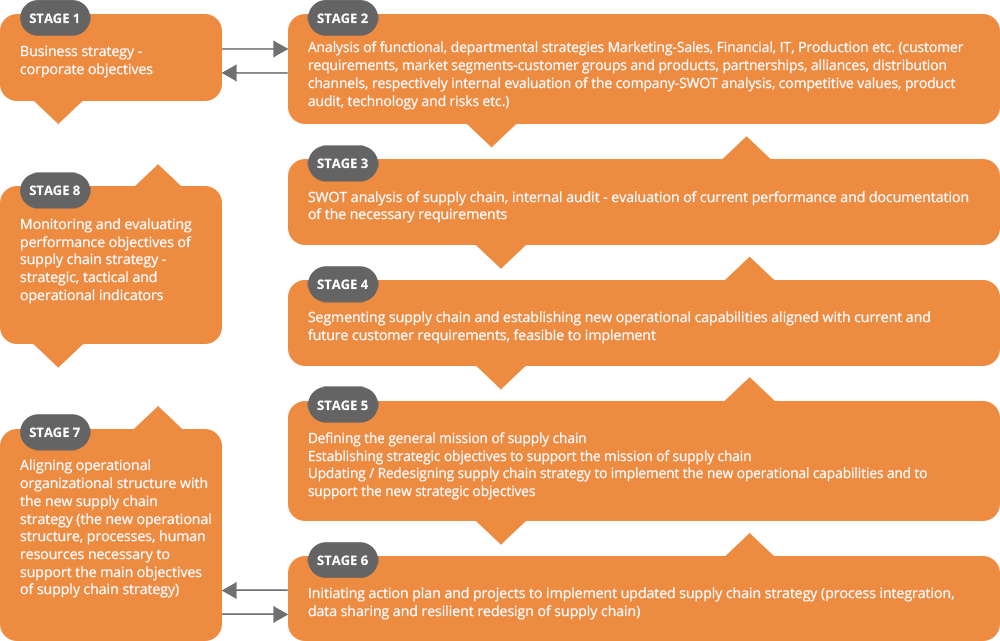Logistics trends and strategies in 2022
Logistics and supply chain operations continue to be affected today by the vulnerabilities of supply and production chains from the 2020-2021 period, but also from recent periods, determined by:
Which supply chain model do we choose to respond to the current and future operational challenges of the supply chain?

The research carried out by Gartner in February 2021 based on the data of a sample of over 1,300 supply chain professionals showed that:
- 87% plan to invest in supply chain resilience in the next two years
- 89% want to invest in agility
- 60% of the respondents admit that their supply chain models were not designed for resilience, but for efficiency, i.e. designed as a function of reducing costs in achieving marketing-sales strategy or, worse, as a cost center of the company’s business support services
Therefore, the challenge of any supply chain manager in the next period will be the redesign, based on the lessons learned from the supply chain vulnerabilities of 2020-2021, but also recent ones, of a SC model that combines cost optimization solutions with of flexibility, sustainability and resilience.
When it is necessary to redesign a supply chain model?
The redesign of a supply chain model is necessary when important changes occur in a company’s business strategy, determined by:
- Activity restriction or business growth through mergers and acquisitions (reallocation of existing resources or allocation of new resources)
- Expanding/changing sales channels (where to buy and where to pick up the goods)
- Entering new markets – the expansion of the distribution/production network or the increase of existing capacities is required
- Expanding or updating the range of products by selecting new suppliers or deselecting existing ones (introducing new product lines or updating existing products by expanding functional characteristics and design changes, where and when)
- Important changes in the client portfolio (appearance of large clients, increase or decrease in the number of small clients, changes in client requirements)
- Changes in the internal and international regulatory environment (the introduction of new restrictions or the emergence of new opportunities for operational expansion)
- The continuous reduction of the level of customer service, the reduced adaptability to new market requirements and the dynamics of product demand models – implies the introduction of new processes or the improvement of existing ones, the improvement of delivery times and/or the correct management of life cycles of the products
- The decrease in the profit margin as a result of the increase in production costs and transport tariffs during the energy crisis – it is necessary to reduce customer service costs by renegotiating supply and transport contracts and optimally reconfiguring the supply chain network in order not to affect the quality of commitments made to supply chain members
- Other situations (pandemic, Brexit, wars, international terrorism, natural disasters, climate change, global financial crises, etc.)
How to competitively design the new supply chain model?
In today’s complex business environment, most companies will want to rethink their supply chain operating models to become more resilient, responsive and efficient. There is NO single model for successful operation of all companies’ supply chains.
The same design principles can lead to very different supply chain operating models. The diversity of operating models of supply chains is determined by the specifics of the following factors:

Therefore, a redesign of the operating model should take into account both the business environment, the objectives and the business strategy, as well as the specific functional characteristics of the company in the practical implementation of the supply chain strategy. Think strategically when designing the supply chain model, don’t worry about optimization or timely resolution of some problems that have arisen.
Michael Hammer, a visionary leader in process redesign and management, said: “High-performance operational processes are necessary but not sufficient for a company’s success”.
In other words, you can have the best operational processes in the world, if the company’s strategy does not give you the right direction, you cannot achieve your business goals. Many companies that have not integrated supply chain strategy into their business strategy have experienced many changes and disruptions in 2021.
Regardless of the changes made in the business objectives, i.e. reducing costs, expanding the product range, rationalizing assets, increasing the level of customer service, expanding the market share, you must ensure that the changes made in SC support the achievement of the new objectives of the business strategy. Without strategy you cannot be competitive. Sometimes business and SC strategies are a little out of phase and need to be aligned to focus on what you want to achieve in the next period.
The stages of correct design of new supply chain model
For the current year 2022 and the following period, develop a configurable supply chain system. To reconfigure the supply-distribution chain in response to changes in the business environment, the structure of your supply chain network must be flexible in relation to the physical, tangible assets represented by factories, distribution centers, retail stores, showrooms, etc. and the intangible assets represented by systems software and management of supply chain processes.

The creation of a flexible supply chain structure, easily configurable, involves strategically ensuring the balance between the use of own assets and access to third-party assets.
Examples:
All these examples are based either on outsourcing processes that do not bring competitive advantages, or the development of coordination and control systems of collaborative supply chain processes.
For example: own distribution center vs. third party supplier’s distribution center. In order to obtain access to third-party distribution assets, a service contract will be concluded with 3PL storage and transport providers, and the coordination and control processes of collaborative fulfillment activities will be carried out by using a common software platform.
By developing an internal supply chain network with own and third-party assets, the configuration of the supply chain network is not fixed, on the contrary, it is flexible and easily configurable, and a change in the market related to the reduction of demand or the expansion of the business to new markets will allow the rapid reconfiguration of the supply chain.
We recommend that, in order to understand the vulnerabilities of a supply chain in the development of a flexible, reconfigurable structure, you initially use your previous professional experience obtained from implementation of best practices focused exclusively on cost reduction at the expense of resilience: Lean and Just In Time (JIT), rationalization of the number of suppliers and the use of unique sources of supply, outsourcing, global centralization of production and distribution.
Later, in order to respond more easily to the future challenges of logistics chains, add practices focused on efficiency that were previously mentioned, to the resilience and sustainability best practices related to segmentation, flexibility and agility.
The joint use of efficiency, resilience and sustainability practices will help you in the future to correctly design an efficient, flexible and reconfigurable structure of the new supply chain model.
We expect a paradigm shift from “design-for-efficiency” to “design – for- resilience”.
Note: The design of a supply chain system with a flexible, reconfigurable structure strategically offers the advantages of rapid system updating, thus avoiding the high costs of its total replacement or redesign.
In fig. 1 you can see a simplified plan in 8 stages that helps you increase the performance of the supply chain in the following period:

Fig. 1. The stages of the methodology for updating and implementing the supply chain strategy
You have read Article 1 of the Series “Logistics trends and strategies in 2022”
In the second article we will talk about the stages of establishing the supply chain strategy.







